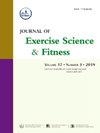Mediation role of telomere length in the relationship between physical activity and PhenoAge: A population-based study
IF 2.4
2区 医学
Q2 SPORT SCIENCES
引用次数: 0
Abstract
Background
The relationship between physical activity (PA), telomere length, and phenotypic age (PhenoAge) represents a pivotal area of investigation in aging research.
Methods
The study encompassed a cohort of 6200 participants aged 20 years and above, sourced from the National Health and Nutrition Examination Survey (NHANES). Physical activity (PA) levels were assessed employing the Global Physical Activity Questionnaire, while DNA samples were collected to determine telomere length, measured in base pairs. PhenoAge, an emerging aging index relying on nine distinct chemical biomarkers, was computed.
Results
Incorporating a fully adjusted model, our analysis showed significant correlations between PA engagement and PhenoAge [Low PA, β (95 % CI): 0.039(-0.071,-0.008), p = 0.021; Moderate PA, β (95 % CI): 0.058(-0.082,-0.034), p < 0.001; High PA, β (95 % CI): 0.069(-0.096,-0.042), p < 0.001]. Furthermore, a positive link emerged between elevated PA levels and telomere length, with a β (95 % CI) of 0.011(0.001, 0.022), p = 0.034. A mediation analysis was performed, demonstrating that telomere length mediated the connection between PA and PhenoAge, with a proportion mediated calculated at 3.57 %.
Conclusions
Our findings suggest that PA may play a key role in mitigating aging processes by preserving telomere length, highlighting the potential of PA as a target for interventions aimed at promoting healthy aging and longevity.

端粒长度在体力活动和表型年龄关系中的中介作用:一项基于人群的研究
身体活动(PA)、端粒长度和表型年龄(PhenoAge)之间的关系是衰老研究中的一个关键领域。方法本研究纳入6200名年龄在20岁及以上的参与者,这些参与者来自国家健康与营养检查调查(NHANES)。采用全球身体活动问卷评估身体活动(PA)水平,同时收集DNA样本以确定端粒长度,以碱基对测量。表型年龄是一种新兴的衰老指数,它依赖于九种不同的化学生物标志物。结果结合一个完全调整的模型,我们的分析显示PA参与与表型年龄之间存在显著相关性[Low PA, β (95% CI): 0.039(-0.071,-0.008), p = 0.021;温和的爸爸,β(95% CI): 0.058 (-0.082, -0.034), p & lt;0.001;高PA、β(95% CI): 0.069 (-0.096, -0.042), p & lt;0.001]。此外,PA水平升高与端粒长度之间存在正相关,β (95% CI)为0.011(0.001,0.022),p = 0.034。进行了中介分析,表明端粒长度介导了PA和PhenoAge之间的联系,其中介比例计算为3.57%。结论研究结果表明,PA可能通过保持端粒长度在减缓衰老过程中发挥关键作用,突出了PA作为促进健康衰老和长寿干预目标的潜力。
本文章由计算机程序翻译,如有差异,请以英文原文为准。
求助全文
约1分钟内获得全文
求助全文
来源期刊
CiteScore
5.10
自引率
3.60%
发文量
54
审稿时长
31 days
期刊介绍:
The Journal of Exercise Science and Fitness is the official peer-reviewed journal of The Society of Chinese Scholars on Exercise Physiology and Fitness (SCSEPF), the Physical Fitness Association of Hong Kong, China (HKPFA), and the Hong Kong Association of Sports Medicine and Sports Science (HKASMSS). It is published twice a year, in June and December, by Elsevier.
The Journal accepts original investigations, comprehensive reviews, case studies and short communications on current topics in exercise science, physical fitness and physical education.

 求助内容:
求助内容: 应助结果提醒方式:
应助结果提醒方式:


